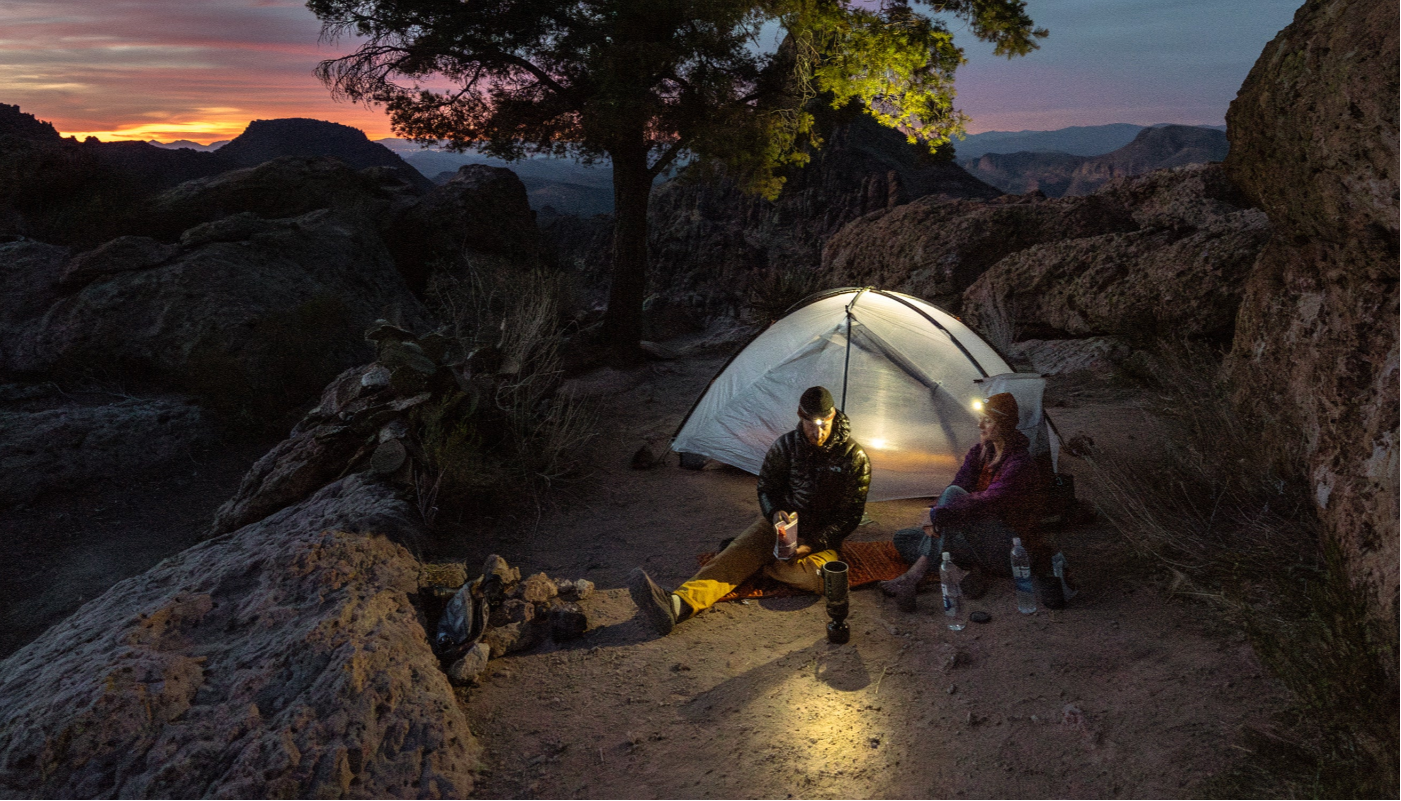Words and Photos by Izzy Tonneson @izzytonneson
When I got off trail earlier this year, I knew I needed to take a hard look at what went wrong.
Stepping away from the Calendar Year Triple Crown wasn’t an easy decision, but in the months since, I’ve been unpacking the missteps and assumptions that ultimately led to my departure.
 My first mistake was starting the CYTC in mid-April. By definition, the challenge requires hiking all 7,955 miles of the PCT, CDT, and AT within a single calendar year, so within 2025. By starting on April 6, I effectively cut the 365 days down to just 269. I couldn’t start earlier, since I didn’t finish college until mid-February. To complete the CYTC in 269 days, I would’ve needed to average an ambitious 29.6 miles per day without even accounting for rest days, travel delays, or bad weather. And realistically, taking a zero day or two every few weeks—whether for recovery, resupply, or logistics—would further reduce the number of hiking days and push the required daily mileage even higher, likely into the low 30s. The margin for error was slim to begin with, and the schedule left almost no room for anything to go wrong.
My first mistake was starting the CYTC in mid-April. By definition, the challenge requires hiking all 7,955 miles of the PCT, CDT, and AT within a single calendar year, so within 2025. By starting on April 6, I effectively cut the 365 days down to just 269. I couldn’t start earlier, since I didn’t finish college until mid-February. To complete the CYTC in 269 days, I would’ve needed to average an ambitious 29.6 miles per day without even accounting for rest days, travel delays, or bad weather. And realistically, taking a zero day or two every few weeks—whether for recovery, resupply, or logistics—would further reduce the number of hiking days and push the required daily mileage even higher, likely into the low 30s. The margin for error was slim to begin with, and the schedule left almost no room for anything to go wrong.
My second mistake was assuming that nothing would go wrong. That’s not to say I was naïve—I’m experienced enough to know that challenges are inevitable, and I’ve become adept at reacting and problem-solving when backcountry situations arise, whether medical issues or external hazards. The real mistake was failing to factor that reality into my planning. The constrained timeline left me with no room to react and adapt. Any delay, even a minor one, threatened to throw off the entire schedule.
 Within the first month of the PCT, a handful of weather events created a kind of yo-yo effect, where I was either hiking 0 miles in a day or pushing 40 just to stay on pace. I was operating in extremes, constantly trying to make up time rather than moving steadily. It was demoralizing to feel the clock ticking while forced to wait out a storm or heatwave, knowing the safe choice was to stop, but the pressure of the schedule made that feel like failure. Even on the days I did hike, the mental weight of falling behind made it hard to enjoy the trail. The push to stay on pace made the transition from on-trail to off-trail time feel jarring and unbalanced, and it turned what should’ve been restorative moments into stressful ones.
Within the first month of the PCT, a handful of weather events created a kind of yo-yo effect, where I was either hiking 0 miles in a day or pushing 40 just to stay on pace. I was operating in extremes, constantly trying to make up time rather than moving steadily. It was demoralizing to feel the clock ticking while forced to wait out a storm or heatwave, knowing the safe choice was to stop, but the pressure of the schedule made that feel like failure. Even on the days I did hike, the mental weight of falling behind made it hard to enjoy the trail. The push to stay on pace made the transition from on-trail to off-trail time feel jarring and unbalanced, and it turned what should’ve been restorative moments into stressful ones.
A month in—well past Kennedy Meadows and the end of the PCT desert section—I took a hard look at the situation. I realized that, yes, staying on pace and completing the CYTC was still within reach. But doing so would come at a cost: I would be miserable for most of the journey. At that point, it became clear to me that the greater failure wouldn’t be choosing to quit; it would be forcing myself to continue and growing to hate the experience in the process.
 I think for many of us who take on a thru hike, it’s easy to view completion as the sole metric of success. There’s something deeply satisfying— and narratively clean —about being able to say, “I thru hiked___,” tracing a continuous footpath from one terminus to the other. That clarity gives the journey a sense of finality. But that mindset can also overshadow the deeper, more personal reasons we set out on these trails in the first place.
I think for many of us who take on a thru hike, it’s easy to view completion as the sole metric of success. There’s something deeply satisfying— and narratively clean —about being able to say, “I thru hiked___,” tracing a continuous footpath from one terminus to the other. That clarity gives the journey a sense of finality. But that mindset can also overshadow the deeper, more personal reasons we set out on these trails in the first place.
I hike to inhabit a different rhythm, one that is not marked by the trail’s start or end, but by everything that unfolds between them. In that in-between space, the usual boundaries fall away. Walking all day, every day, you begin to connect with people in a different way. Relationships form quickly, stripped of small talk and pretense. You share routines, aches, food, views, silence. I hike to notice, to pay attention to and to attend to the natural world.
Out here, nothing demands my attention the way a screen or a schedule does. Instead, I offer it freely. That kind of presence wasn’t possible during my CYTC attempt this past year. Even though I was constantly surrounded by nature and often crossed paths with other hikers, I rarely felt truly connected to either. There was little time to share a moment with someone, or to sit still and simply observe the land I was hiking through. Paradoxically, I was moving through some of the most beautiful places in the world, yet often too focused on forward progress to truly see them.
 Failing a thru hike feels personal. We invest so much time and effort into planning and preparation, but often, finishing a thru-hike boils down to luck. That is why the idea of a perfect, continuous thru hike has become increasingly unrealistic. In recent years, extreme weather events have disrupted even the best-laid plans on National Scenic Trails. A few examples that come to mind include record snow levels on the PCT in 2023, a hurricane hitting the AT in 2024, widespread wildfires again on the PCT that same year, etc. Interruptions are becoming more common than not. As a result, many hikers—myself included— have begun to rethink what it means to complete a thru hike, expanding the definition to include more flexible, adaptive approaches. It is now more common to hop around to safer sections, returning later in the year to finish impassable stretches, or reordering the route to hike all the miles in a piecewise way.
Failing a thru hike feels personal. We invest so much time and effort into planning and preparation, but often, finishing a thru-hike boils down to luck. That is why the idea of a perfect, continuous thru hike has become increasingly unrealistic. In recent years, extreme weather events have disrupted even the best-laid plans on National Scenic Trails. A few examples that come to mind include record snow levels on the PCT in 2023, a hurricane hitting the AT in 2024, widespread wildfires again on the PCT that same year, etc. Interruptions are becoming more common than not. As a result, many hikers—myself included— have begun to rethink what it means to complete a thru hike, expanding the definition to include more flexible, adaptive approaches. It is now more common to hop around to safer sections, returning later in the year to finish impassable stretches, or reordering the route to hike all the miles in a piecewise way.
We’ve redefined thru hiking from rigid continuity toward a more resilient and realistic vision of success on trail. When a goal of mine, such as completing the CYTC does not come to fruition, I pause to reflect and ask myself: Is the goal itself flawed? Or is my execution at fault? After careful consideration, I am confident that I still want to hike the CYTC. However, my approach will evolve.
In 2026, I plan to restart the CYTC journey in January, with a revised strategy. By beginning earlier in the year, I aim to maximize my time on trail and better accommodate the unpredictable nature of such an undertaking. If I were to pinpoint a single reason my 2025 CYTC unraveled, it would be a lack of flexibility in my original plan. Hopefully, this earlier start will represent a more realistic plan that aligns better with my goals and values for thru hiking.























